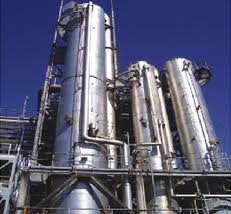Chemical and Process Engineering Resources
Extractive Distillation: An In-Depth Look
Nov 08 2010 01:40 PM | Chris Haslego
Distillation is the most widely used separation technique in the chemical and petroleum industry. However, not all liquid mixture are amenable to ordinary fractional distillation. When the components of the system have low relative volatilities (1.00 <Â a < 1.05), separation becomes difficult and expansive because a large number of trays are required and, usually, a high reflux ratio as well.
Both equipment and utilities costs increase markedly and the operation can become uneconomical. If the system forms azeotropes, as in a benzene and cyclohexane system, a different problem arises, - the azeotropic composition limit the separation, and for a better separation this azeotrope must be bypassed in some way. At low to moderate pressure, with the assumption of ideal-gas model for the vapor phase, the vapor-liquid phase equilibrium (VLE) of many mixture can be adequately describe by the following Modified Raoult's Law:
| Eq. (1) |
 where:
yi = mole fraction of component i in vapor phase
xi = mole fraction of component i in liquid phase
P = system pressure
Psat = vapor pressure of component i
?i = liquid phase activity coefficient of component i
When ?i = 1, the mixture is said to be ideal Equation 1 simplifies to Raoult's Law. Nonideal mixtures  (?i ? 1) can exhibit either positive (?i > 1) or negative deviations (γi < 1) from Raoult's Law. In many highly nonideal mixtures these deviations become so large that the pressure-composition (P-x, y) and temperature-composition (T-x, y) phase diagrams exhibit a minimum or maximum azeotrope point. In the context of the T-x, y phase diagram, these points are called the minimum boiling azeotrope (where the boiling temperature of the azeotrope is less than that of the pure component) or maximum boiling azeotrope (the boiling temperature of the azeotrope is higher than that of the pure components). About 90% of the known azeotropes are of the minimum variety. At these minimum and maximum boiling azeotrope, the liquid phase and its equilibrium vapor phase have the same composition, i.e.,
| xi = yi for i = 1, ..., c | Eq. (2) |
Two main types of azeotropes exist, i.e. the homogeneous azeotrope, where a single liquid phase is in the equilibrium with a vapor phase; and the heterogeneous azeotropes, where the overall liquid composition which form two liquid phases, is identical to the vapor composition.
Most methods of distilling azeotropes and low relative volatility mixtures rely on the addition of specially chosen chemicals to facilitate the separation. The selection of the separating agent will be discussed later.
The five methods for separating azeotropic mixtures are:
1. Extractive distillation and homogeneous azeotropic distillation where the liquid separating agent is completely miscible.2. Heterogeneous azeotropic distillation, or more commonly, azeotropic distillation where the liquid separating agent, called the entrainer, forms one or more azeotropes with the other components in the mixture and causes two liquid phases to exist over a wide range of compositions. This immiscibility is the key to making the distillation sequence work.
3. Distillation using ionic salts. The salts dissociates in the liquid mixture and alters the relative volatilities sufficiently that the separation become possible.
4. Pressure-swing distillation where a series of column operating at different pressures are used to separate binary azeotropes which change appreciably in composition over a moderate pressure range or where a separating agent which forms a pressure-sensitive azeotrope is added to separate a pressure-insensitive azeotrope.
5. Reactive distillation where the separating agent reacts preferentially and reversibly with one of the azeotropic constitutes. The reaction product is then distilled from the nonreacting components and the reaction is reversed to recover the initial component.

 FB
FB

3 Comments
nice discription. thanks
Thank you for brief explaination.
good